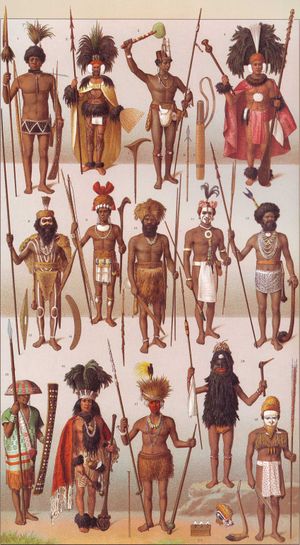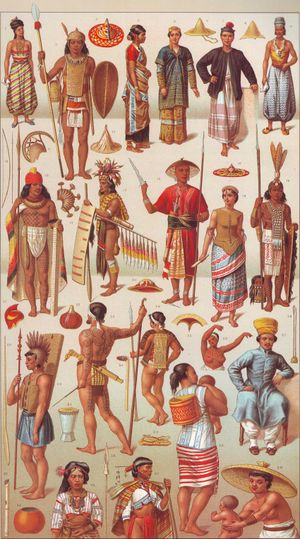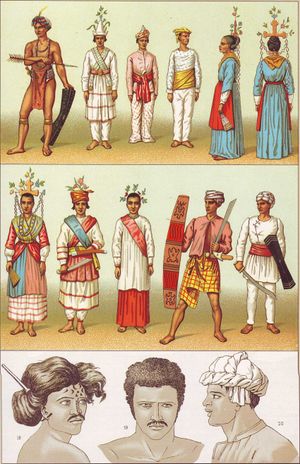Laurent Nautilus/THE HISTORICAL ENCYCLOPEDIA OF COSTUME
Материал из ВикиВоины
< Участник:Laurent NautilusMALAYS - PAPUANS - ABORIGINES[править]
THE ANTHROPOLOGIST RIENZI claimed to have identified four distinct races among the archipelagoes and islands of the Pacific Ocean. Later, though, it became accepted that there are only three principal races: the Malays, who used to inhabit the coasts until invaders chased them inland; the Papuans, fishermen who live principally along the shores; and the nomadic Australian Aborigines.
1, 15 & 17 Papuans. The warrior in 1 wears only a loincloth, with an amulet in the form of a human figure round his neck, His hair is decorated with a wooden comb and a plume of feathers, and a sabre called a peda is worn round his neck.
15 shows a simple woollen tunic with a fringed hem. The shoulder belt is decorated with feathers and the hemispherical leaf hat is adorned with shells.
The grass-skirted warrior in 17 has first dyed his hair red in lime water, then whitened it with powder made from pulverised coral. The effect is crowned with a diadem of cassowary feathers and a headband of small shells. The warrior's comb is adorned with a plume of feathers from a bird of paradise.
3 & 18 Members of the Kanaque tribe from New Caledonia, dressed for a feast day. Styles were varied and individual, hut most tied their hair up with brightly coloured material topped with a plume of feathers. Some wore beards, while others shaved with sharpened oyster shells; but nearly all pierced their ears. The warrior (18) wears a mask designed to frighten his enemies.
8 & 10 Aborigines, who did not know the bow and arrow, but relied on wooden spears and boomerangs (13 & 14).
9 An Arossien, from San Cristobal in the Solomon Islands. A warrior tribe, equipped with bows and arrows, spears and bludgeons (5), the Arossiens often pierced their noses and hung ornaments, such as parrot feathers, from them. Here the hair is tied up with a bamboo comb and decorated with fringes that hang down on either side of the parting. The bracelets and belt are made from white, red and black beads of shell, and are used as currency.
11 A native of the Admiralty Islands. Here the warrior's face is painted white and his hair is decorated with hibiscus and feathers. He has a collar of small shells and as a chest-ornament wears a white ring of shell with fine scales attached. The arm bone of an enemy hangs round his neck. His bracelets are made from large shells, and he wears a finely worked loincloth.
12 A Vitien warrior, whose hair has been reddened either with lime water or the bark from a tree soaked in coconut oil, then curled back around the head and decorated with a comb of parrot feathers. He wears a collar of shells, pigs' teeth and rats' or bats' jaws.
19 A New Hebridean warrior, with a wooden helmet whose visor has a human face painted on it. This mask opens at the level of the mouth and ends in the form of a beard. His chest is covered with a decoration of plaited bulrushes. from which hang three pendants made from teeth. His spear is heavily spiked with barbs made from human bones.
JAVA - BORNEO - SINGAPORE - PHILIPPINES[править]
AMONGST THE TRIBES OF OCEANIA it was often the custom for mothers to flatten their childrens' noses artificially, and to encourage the use of varnish to darken their teeth. Tribesmen would make themselves more attractive - and more frightening to their enemies - by covering their bodies with tattoos.
1 & 9 A Javanese woman and man. The woman wears a light turban and long and full trousers that are gathered in around the waist by a narrow thong. Two chains hang from a gold collar studded with gems.
The man (9) is similarly dressed, but with a cut-off conical bonnet and a garland of flowers.
2 & 19 Natives of Borneo in battle dress. The upper body (2) is protected by a breast-plate of fish skin. The loin cloth under the breastplate ends in a small apron at the front. The helmet, like a thick forage cap, is of woven cane. The war jewellery consists of a collar and bracelets made from tiger claws.
The second native (19) shows several variations in dress. The front of his helmet represents a human face, while its top is made of the skull of a rhinoceros bird decorated with argus feathers. His sword hilt is decorated with the hair of those he has defeated and on the ground is a basket, used to carry severed heads.
5 & 7 Karens from Borneo. The man's clothing is for everyday wear and the woman is in full ceremonial dress.
12 A warrior of the king's guard from the Islands of Hawaii.
15 A Binua, from Singapore, wearing full battle dress. The lance is entirely wooden and the blowpipe, the national weapon, is much shorter and more inaccurate than later versions, such as those tipped with iron points (19 & 24). The Binua's clothing and jewellery are made entirely from natural materials: a leopard skin hangs over one shoulder, and his hat is crowned with feathers.
16 A Malay from Borneo. He has a Muslim's shaven head, and a hat in the shape of an inverted basin that serves as a parasol. Malays usually carry two daggers: one at the front and one slung over the shoulder.
18 A woman from the Timor Islands. Her upper body is covered in a tissue of silk, threaded with gold and she wears a silk cap and a dyed cotton skirt that is Javanese in style. Unless in the presence of strangers, a skirt would be her only garment.
23 & 24 Dayas in hunting and battle dress. The bun hairstyle (23) shows Polynesian influence and the breastplate (24) is made of vegetable fibres.
25 A child's fly swatter.
30 A Philippino Indian fisherman. This armour looks like chain mail, but is, in fact, made of vegetable fibres.
38 & 39 Daya women. The sleeveless jacket (38) is made entirely of cotton. The small wooden box attached by cords serves both as a pocket and as a bag. The second woman (39) wears only a loincloth, which goes down to the knee. Her hat is made of woven straw and her bracelet of brass wir
MALAYSIA - INDONESIA[править]
THE PEOPLES OF MALAYSIA, where a poorly turned out man invites scorn, are the best dressed in Oceania: even in the poorest, most distant islands the Malaysians never go about naked. Clothes are generally made from local products, but blue materials and cotton are also imported from the two Americas.
The principal item of the male costume is the sarong. This is made from a piece of material called a pagne, six or eight feet long by three feet wide, which is wrapped round the hips and sometimes secured with a belt. Women use pagnes, too, though in their case they are knotted at the throat and hang down to the ankles. Women's hair is usually tied up at the back of the head and fastened with a pin made of horn, buffalo or brass.
All the illustrations in 1 & 2 are of natives of Gorontalo, a town on the Bay of Tomini in Celebes.
1.1 Alfour de Tondano, ruler of Gorontalo, in ceremonial dress that copies the ancient national costume. He wears an elegant loincloth of richly coloured silk. A white headscarf covers the hair, which is held up at the front by a silken headband containing the feather of a bird of paradise.
1.2 Contemporary ceremonial dress. The scarf crossing shoulders and chest is held in place by a belt; this device was used in the company of Christian women as a symbol of faith. The costume is made of cotton and the scarf of silk.
1.3 & 4 Sailors, both with cotton costumes and silk sashes. One headscarf (3) is of cotton; the other is of silk.
1.5 & 6, and 2.1 Catholic women, wearing chemises, handkerchiefs round their necks and aprons. Showing both European and Oriental influences, these are devotional garments.
1.5 & 6 show the same woman from two different angles. She wears an enormous wooden hair comb, which rises above her head in the shape of a cross. This is topped with artificial flowers from which are hung small chains of brass encrusted with shells.
2.1 This woman wears a gilded belt and carries a fan of gilded leaves; her necklace is made of glass beads.
2.2 One commentator says that "the chiefs wore either a Christian costume, which tended to give them rather a starched appearance, or a Muslim costume that suited them a great deal better."
Here the chief has adopted a Muslim style of dress, but the shoulder sashes, crossed over the chest, may indicate that the man is a Christian and perhaps the husband of the woman next to him.
2.4 A warrior dressed in a chequered Malay sarong, a short open jacket and a headscarf wrapped round the head like a turban. All these garments are made of cotton. In his left hand he carries a kern pilan, a type of sabre whose blade is wider at the tip than at the hilt. The tall narrow shield is called a salawako.
2.5 A member of the Gorontalo militia in his uniform.
3 The majority of Oceanic tribes do not cut their hair short and wear nothing on their heads. The characteristic style is shown on the left: the hair has been allowed to grow long, and is fastened at the back with a bamboo clasp; the forehead and nose are decorated with markings. Short-haired styles, with and without a headdress, are shown to the right.
Все отсюда: http://rutracker.org/forum/viewtopic.php?t=3037876




